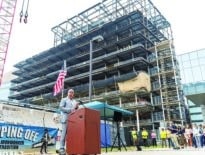
Cambridge Assoc. and International Research + Management will relocate their headquarters to MP Boston’s Winthrop Center skyscraper upon its completion in 2023. Image courtesy of MP Boston
The recent heat emergency in Boston and extreme heat events worldwide have further underscored the consequences of the climate crisis and the need for immediate action to mitigate climate change at the state and federal level.
The built environment is a significant contributor to climate change, with buildings accounting for nearly 40 percent of global energy-related carbon emissions. Implementing more energy efficient design methods for buildings is an important starting point for mitigating the built environment’s impact and reducing carbon emissions. The Passive House standard is the most aggressive energy efficient strategy currently in use worldwide. With global building floor area expected to double by 2060, it is with a pressing sense of urgency that the real estate development community is increasingly looking to Passive House to curb energy use in buildings.
A Foundation for Healthy Buildings
As director of sustainable development at MP Boston – the developer behind Boston’s forthcoming Winthrop Center, the largest Passive House office building in the world – I am passionate about raising awareness around Passive House, with hopes of inspiring others to pursue energy efficient design solutions that will contribute to a more sustainable future.
Originally applied to single-family residences, Passive House is becoming increasingly adopted by architects and developers for large-scale commercial buildings, including office towers across the globe.
Based on a set of design principles for attaining high levels of indoor comfort with minimum energy consumption (essentially, reducing the amount of energy required to heat and cool a building), the Passive House design methodology can reduce energy demand up to 90 percent. To achieve Passive House designation, a building must have a high amount of thermal insulation through a robust facade, triple-glazed windows and an airtight building envelope that helps eliminate heating and cooling inefficiencies and dramatically reduces energy usage. In non-residential buildings, increasing efficiency is largely focused on ventilation, heating and air conditioning.
Designed by Handel Architects, in collaboration with SOCOTEC and Steven Winters & Assoc., Winthrop Center’s 812,000-square-foot office space is a pilot project for Passive House development, representing the first time a developer has applied the Passive House approach to a building of this size, scale and typology. Winthrop Center is the most energy-efficient large-scale building ever built in a cold climate, where the Passive House application is critically important because Passive House dramatically lowers heating demand.
The office component incorporates a well-insulated building facade, air-tight exterior envelope and advanced energy recovery ventilation system. Passive House buildings like Winthrop Center focus on building envelopes and insulation, creating temperature-controlled structures with fresh air brought in to meet air-quality requirements. Designed to deliver better managed and higher quality air, the building doesn’t just remove heating and cooling inefficiencies; it also positively impacts employee health, productivity and sense of well-being.
We have reached a point where personal health and planetary health are inextricably linked, and it is within this context that Passive House is extremely timely and relevant. The methodology addresses occupant health and wellness while significantly advancing the energy efficiency of buildings, making these dual benefits possible through straight forward principles such as airtight construction.
Passive House Pilot in an Innovation City
The Passive House framework behind Winthrop Center’s office space was conceptualized more than five years ago, in initial discussions with MP Boston and Handel Architects about building a program for a next-generation, high-performance, healthy building that would set a new standard for structures across the globe, not just in Boston. Handel Architects, having previously designed and achieved certification for the largest Passive House residential building in the world for Cornell University in New York City, advocated in the early stages of design for integrating Passive House into the Winthrop Center project. Passive House became an integral part of the project because the standard directly addresses climate issues while delivering a high comfort standard, from thermal and acoustical comfort to high-quality fresh air.
When these initial conversations took place in 2017, there were only a handful of Passive House certified buildings in Massachusetts. MP Boston wanted to apply the standard to a new realm with the large-scale office component, setting a new global standard for integrating health and wellness, sustainability and technology in building design. Trips to Darmstadt, Germany, home to the world’s first Passive House, and The Edge in Amsterdam, which at the time was considered the greenest office in the world, reinforced the desire to deliver a healthy building that addresses climate change. The MP Boston team sought out experts at the Passive House Institute in Darmstadt where the project proposal was met with skepticism, as the Passive House approach had never been applied to such a large-scale office building.
After many conversations, and much collaborative work, MP Boston and Passive House Institute saw the viable path to accomplishing the ambitious goal, and now the project is slated for completion in early 2023.
As the office continues to be reimagined, MP Boston is confident that office tenants will see the value in coming to work at Winthrop Center and demonstrating their core values and knowledge of climate issues, while working in a space that provides a constant supply of healthy, fresh air. The world leader in green investments, Cambridge Assoc., will move its global headquarters to Winthrop Center in spring 2023, occupying 115,000 square feet of office space. International Research + Management, the U.S. fixed income manager with $88 billion in assets under management, is also moving its headquarters to Winthrop Center in fall 2023.
Passive House is increasingly recognized as the design standard of the future, growing in influence since its beginnings in Germany and gaining a wider international following. Some U.S. states – including California, Massachusetts, and New York – are introducing or looking to introduce building code language that acknowledges Passive House design as an indication of energy code compliance.
Boston Tracks Building Energy Use
While a recent U.S. Supreme Court ruling limiting the Environmental Protection Agency’s power to regulate greenhouse gas emissions was a blow to a national strategy to reduce carbon emissions, counties, and states like Massachusetts are showing leadership in climate change mitigation. As more cities and states mandate sustainable buildings and implement advanced energy codes and building performance standards, Passive House design provides a gold standard for policies and regulations that can be applied broadly, resulting in emissions reductions.

Brad Mahoney
Boston’s recently passed building performance standard, BERDO 2.0, requires buildings equal to or over 20,000 gross square feet to annually report on and track energy use. Leveraging available data, we have discovered that a typical class A building in Boston’s existing stock uses 150 percent more energy and existing LEED Platinum buildings in Boston use 60 percent more energy than Winthrop Center’s office space is expected to use once completed.
If the reduction in energy use and greenhouse gas emissions resulting from Winthrop Center’s Passive House design were applied to existing building stock in Boston, the city would save 3 million metric tons of greenhouse gas emissions. This savings would drive city emissions from 6.4 million tons of CO2 to 3.4 million tons of CO2, a full 10 to 12 years ahead of the city’s goal.
Winthrop Center’s office design is just one example of how Passive House can be implemented, directly addressing the challenge that office buildings are among the highest energy users with a significant share of greenhouse gas emissions in cities.
The Massachusetts Department of Energy Resources has drafted plans to update the state energy stretch code to include compliance paths for Passive House as well as Passive House components such as energy recovery ventilation, reduction in thermal bridges, focus on air leakage and continued focus on facade performance.
I am confident that this momentum will continue, and more people in the U.S. will be incentivized to embrace Passive House as a method for achieving radical energy efficiency and providing exceptional comfort. MP Boston wants to redefine how we think about buildings, and our hope is that Winthrop Center will be a beacon for buildings of this size and scale and inspire others to continue exploring innovative design solutions to combat climate change.
Brad Mahoney is director of sustainable development at MP Boston.






